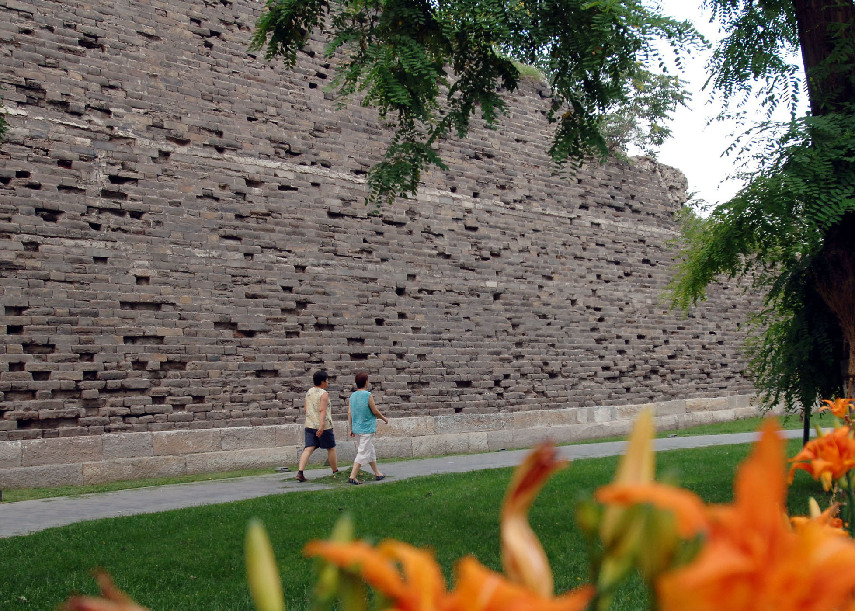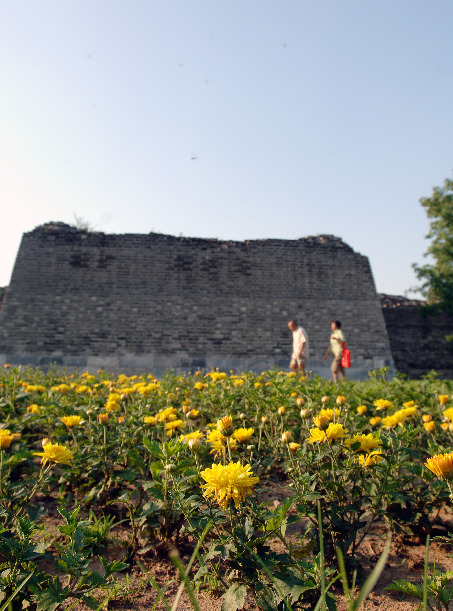
People walk in Beijing Ming Dynasty City Wall Relics Park in Beijing. (Xinhua/Ma Ning)
By Xinhua writers Guo Yifan, Han Zhaoyang
BEIJING, June 30 (Xinhua) -- It may be new knowledge to many that aside from the famous Great Wall in suburban Beijing there are also ancient city walls dotting the bustling downtown of the capital city.
Local resident Guo Liang took a morning stroll at the foot of the brownish-gray city wall that dates back to the Ming Dynasty (1368-1644) in Chongwenmen of Dongcheng District, the city's central area.
Suddenly, she stopped, took out her cell phone and snapped a picture of magpies flying over the ancient wall.
Originally built to protect Beijing from the invasion of outside forces, the ancient city wall is now part of the modern life of Beijingers.
Besides people leisurely walking along the 1.5-km-long Ming city wall, there are also people practicing Tai Chi, square dancing and jogging.
"I love this place. To be more engaged I have adopted five trees in the park here; my favorite one is just under the Ming city wall," said Guo.
The Ming city wall near Guo's home is a section of a 40-km city wall built around the ancient city 580 years ago. Aside from this area, which is the most well-preserved wall in Dongcheng District, part of the city wall can also be found in Xicheng District.
The now carefully protected heritage site has seen its fair share of challenges. A large part of the Ming city wall was demolished in the 1950s and 1960s, giving way to urban construction.

Flowers bloom in Beijing Ming Dynasty City Wall Relics Park in Beijing. (Xinhua/Ma Ning)
Ms Wang, 67, was involved in the project of transporting the bricks removed from the walls to support modern construction.
"Back then, I was in middle school. The ancient walls were removed to meet the needs of modern traffic since the horse-and-buggy era was over," said Wang.
"In the 1960s, when the Beijing subway was built, the Ming wall was surrounded by materials and waste. Later on, some people even removed bricks from the wall to build their own houses," recalled Li Hongchen, a native Beijinger in his 70s.
Fortunately, things turned around. Realizing the need to protect the precious cultural relics, authorities took a variety of actions to protect the ancient city wall during the past several decades.
"To repair the walls, the government called on local people to donate bricks, and those who lived too close to the walls were relocated," said Li Jun, with the administrative office of the Ming City Wall Site Park.
The park was built in 2002. Li told Xinhua that some 4 million people visit the park every year.
To Wang's comfort, 18 years ago, a park called Beijing Imperial Root Ruins Park was built near her home, not far away from Wangfujing in Dongcheng District. Inside the park, a part of the ancient city wall was rebuilt.
"Fifty years ago, I used to escape the summer heat under the gate of the ancient wall, and now the park is also a great place to go in the summertime," said Wang.
The remaining ancient city walls which witnessed the ups and downs of history also provide people with a place to recall old memories.
At an exhibition about Beijing's ancient city wall held at the Ming City Wall Site Park, Luo Dazhi, a 62-year-old man from central China's Hunan Province, tells the story of the city wall to his five-year-old granddaughter.
Luo said his greatest pleasure is to show his granddaughter cultural relics and historic sites in his spare time.
"Beijing is a famous historical and cultural city. It's a great place for children to learn about traditional Chinese culture," he said.
Beijing released an urban construction plan in 2017, which stressed the protection of the ancient city.
It elaborated that authorities should combine protection and modern development of cultural relics so as to benefit the public.



